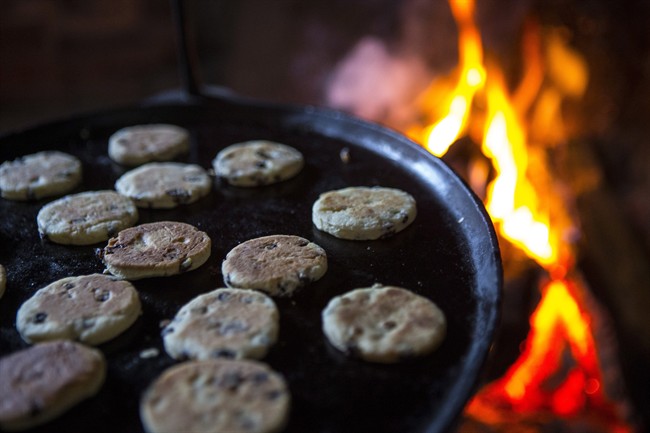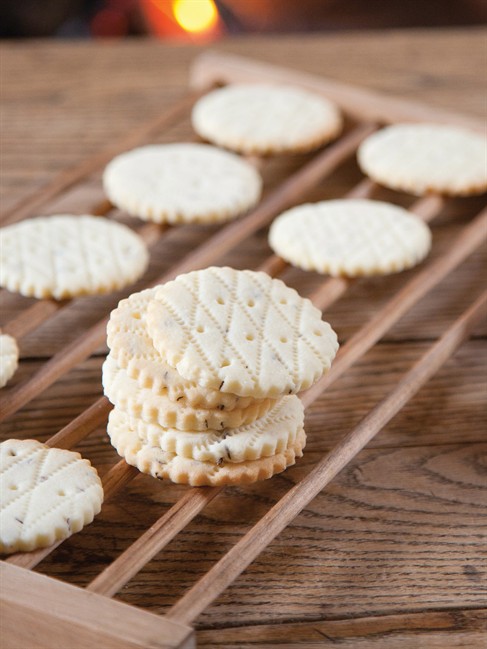Setting a Fine Table by Elizabeth Baird and Bridget Wranich contains 30 recipes that have been researched and tested by the Volunteer Historic Cooks at Fort York in Toronto.

Here are three recipes for sweets that would have been served to the officers who made their home at the military outpost and which are enjoyed today by visitors.
You can try your hand at making these treats as originally written or use the modern adaptation developed by the volunteer cooks.
Shrewsbury Cakes
Shrewsbury Cakes, a regional cake from the county town of Shrewsbury (pronounced SHROES-burr-ee) in Shropshire, England, are one of the most popular recipes made at Fort York. For many of the visitors who sample these crisp, buttery “cakes” (cookies) in the historical kitchen, the caraway seeds in the recipe are at first a novelty, then a delightful surprise.
The original recipe uses less flour and is difficult to roll out. The modern equivalent includes more flour, is easier to roll out and still makes a delicious crisp cookie.
Historic recipe excerpted from “The London Art of Cookery” (John Farley, 1800):
Beat half a pound of butter to a fine cream, and put in the same weight of flour, one egg, six ounces of beaten and sifted loaf sugar, and half an ounce of caraway seeds. Mix them into a paste, roll them thin, and cut them round with a small glass or little tins; prick them, lay them on sheets of tin, and bake them in a slow oven.
- What is a halal mortgage? How interest-free home financing works in Canada
- Capital gains changes are ‘really fair,’ Freeland says, as doctors cry foul
- ‘Dangerous message’: Experts slam anti-sunscreen claims circulating online
- As fake Botox cases prompt alert in U.S., Canada says no new issues reported
Modern Equivalent
- 250 ml (1 cup) unsalted butter, softened
- 250 ml (1 cup) granulated sugar
- 20 ml (4 tsp) caraway seeds
- 1 medium egg
- 550 ml (2 1/4 cups) all-purpose flour
Line 2 rimless baking sheets with parchment paper, or lightly grease.
In a large bowl, beat butter and sugar until light and fluffy. Beat in caraway seeds, then egg. Stir in flour in 3 batches. Press dough together, kneading gently until smooth. Divide in half and shape into 2 discs.
(Make-ahead: Wrap each disc of dough separately and refrigerate for up to 1 day. Bring to room temperature to soften before rolling.)
Roll out dough, one disc at a time, on a well-floured work surface to a 5-mm (1/4-inch) thickness. Using a fluted 5-cm (2-inch) cookie cutter, cut dough into rounds. Arrange cookies 2.5 cm (1 inch) apart on prepared baking sheets. Using a comb and small skewer, press a diamond and dot pattern on each cake. Form scraps into a disc and reroll for more cookies.
Bake in the centre of a 180 C (350 F) oven until light golden on the bottom, 12 to 15 minutes. Let firm up on baking sheets for 3 minutes, then transfer to racks to cool completely.
(Make-ahead: Layer in airtight containers. Store at room temperature for a few days or freeze for up to 2 weeks.)
Makes about 70 cookies.
—
Derby or Short Cakes

Derby (pronounced DAR -bee) is a small city in the East Midlands, England. Derby cakes (or short cakes) are one of many examples of regional griddle cakes found throughout the British Isles.
The staff and volunteer historical cooks at Fort York often make these with young visitors, who help mix the dough, roll it out and cut out the rounds. Depending on their age, the children can help turn the scone-like cakes over as they bake on a large, oval cast-iron griddle.
Derby cakes are delicious eaten warm.
Historic recipe excerpted from “The Cook Not Mad; Or, Rational Cookery” (Anonymous, 1831):
Rub one pound of butter into two pounds of sifted flour, put one pound of currants, one pound of sugar, mix all together with half a pint of milk, one egg, two teaspoonfuls of pearlash, roll it out thin; cut it in round cakes and bake them.
Modern Equivalent
This recipe is half the size of the original, which called for one egg. For this half-size recipe, you can use the yolk of a medium egg, or beat the whole egg and add half to the dough, saving the rest for another dish.
- 250 ml (1 cup) currants
- 875 ml (3 1/2 cups) all-purpose flour
- 5 ml (1 tsp) baking soda
- 250 ml (1 cup) unsalted butter, cubed
- 250 ml (1 cup) granulated sugar
- 1 medium egg yolk
- 125 ml (1/2 cup) whole milk
Soak currants in hot water for 5 minutes. Drain and spread out to dry on a towel-lined tray, about 15 minutes.
In a large bowl, whisk together flour and baking soda. Using a pastry blender or your fingertips, work butter into dry ingredients until mixture resembles fresh breadcrumbs. Mix in sugar and currants.
Whisk together egg yolk and milk. Make a well in the centre of the dry ingredients and pour in milk mixture. With a fork, combine all the ingredients to make a soft, but not sticky, dough. Dust hands with flour if necessary to handle dough easily. Divide dough in half. Place a bowl over one-half of the dough while you are working with the other.
On a well-floured work surface, roll out dough, half at a time, to a scant 5 mm (1/4 inch) thickness. Use a 6-cm (2 1/2-inch) cutter to cut out rounds, dipping cutter into flour if necessary to prevent sticking. Reroll scraps to make more rounds.
(Make-ahead: Layer rounds with waxed or parchment paper in airtight containers and freeze for up to 2 weeks. Thaw before baking.)
Bake on a griddle or cast-iron skillet over medium-low to medium heat until golden on the bottom, about 5 minutes. Bake on second side until golden and cakes are cooked through, about 4 minutes. Keep heat moderate or the outside of the Derby Cakes will darken or burn before the insides are cooked.
Makes about 45 cakes.
—
Mackeroons
These almond mackeroons are a go-to recipe the volunteers use when baking samples to offer to visitors in the 1826 kitchen of Fort York. The volunteer historical cooks separate the egg whites into a big copper bowl and, with a whisk, hand-beat the egg whites to glossy peaks or, as some 18th-century recipes say, “to a stiff froth.” At home, a stand or hand mixer makes light work of the whisking. Either method produces handsome mackeroons.
Today, mackeroons (now spelled macaroons) are a meringue made with coconut, but until the mid-19th century they contained finely chopped or pounded sweet almonds. Baird says they are also ideal to serve guests who have a gluten intolerance.
Historic recipe excerpted from “The Art of Cookery Made Plain and Easy” (Hannah Glasse, 1796):
Take a pound of almonds, let them be scalded, blanched, and thrown into cold water, then dry them in a cloth, and pound them in a mortar, moisten them with orange-flower water, or with the white of an egg, lest they turn to oil; afterwards, take an equal quantity of fine powder sugar, with three or four whites of eggs, and a little musk, beat all well together, and shape them on wafer-paper, with a spoon round: bake them in a gentle oven on tin plates.
Modern Equivalent
- 750 ml (3 cups) whole blanched almonds
- 4 medium egg whites (125 ml/1/2 cup)
- 10 ml (2 tsp) orange flower water
- 500 ml (2 cups) superfine granulated sugar
Line 2 rimless baking sheets with parchment paper.
In a food processor, chop almonds, scraping down sides of bowl from time to time, until they are the consistency of very coarse sand with some slightly larger pieces. Set aside.
In a separate large bowl, beat egg whites with orange flower water until soft peaks form. Add sugar, about 30 ml (2 tbsp) at a time, beating until stiff peaks form. Sprinkle chopped almonds over egg white mixture and fold in to distribute evenly.
Drop by rounded teaspoonfuls (5 ml) about 2.5 cm (1 inch) apart onto prepared baking sheets. Bake in the centre of a 160 C (325 F) oven until they are dry to the touch but still white and lift easily off the parchment paper, 12 to 15 minutes.
Let cool on pans on a rack.
(Make-ahead: Layer in airtight containers. Store at room temperature for a few days or freeze for up to 2 weeks.)
Makes about 80 mackeroons.
Source: Setting a Fine Table: Historical Desserts and Drinks from the Officers’ Kitchens at Fort York by Elizabeth Baird and Bridget Wranich (Whitecap Books, 2013).


Comments